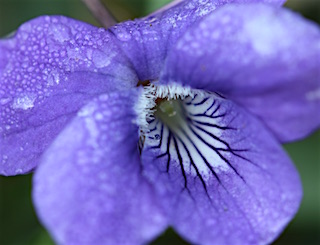
Not the prettiest name for a very pretty flower…Common Dog-violets start to bloom in early Spring, with a second flush in late Summer.
Photo: Amanda Scott
Scientific name: Viola riviniana
Other common names: Dog-violet
What to look for:
• Family: Violaceae (Violet family)
• Flowers: Violet-blue petals, unscented, with dark purple veins, mainly on the lower petal
• Leaves and stem: Heart-shaped leaves are sparsely hairy and long-stalked.
• Height: From 2 cm to 20 cm
• Where: Common across Great Britain, including in woods, grassland, cliffs. Native to Eurasia and Africa.
• When: Flowers in March to May and again in late summer to autumn, from August to October
• Habit: Upright
There is something very precious about a drift of dew-dappled violets shyly peeking out from among the grasses on a spring day.
There are nine species of violet native to Great Britain, and by far the most common is Viola riviniana – the Common Dog-violet. In the early spring, and again in late summer through to early autumn, its delicate blue beauty brightens the hedges, pastures and woods of the British countryside. Found in many different habitats, it is not overly fussy so long as the soil is neither too wet or too acidic.
Other species of Violet you might find on The Lizard include the Heath Dog-violet (V. canina), which likes sandy acidic soils and is paler than V. riviniana, or Sweet Violet (V. odorata), our only scented Violet.


Did you know…?
…The Common Dog-violet is the foodplant for caterpillars of the Pearl-bordered, Small Pearl-bordered, Silver-washed and High Brown Fritillary butterflies.
…The dark purple veins on the lower petal (see image) are nectar guides: ‘landing pads’ helping pollinators find their way to the tasty nectar within.
More information and references:
Mabey, R., 1997. Flora Britannica. Chatto & Windus, London.
Rose, F. and O’Reilly, C., 2006. The Wild Flower Key, 2nd edition. Frederick Warne, London.
Stace, C., 2010. New Flora of the British Isles, 3rd edition. Cambridge University Press, Cambridge.
Published: April 2016
Author: Amanda Scott
Photos: Above – Amanda Scott; below (Violets with Primroses) – © Natural England/Peter Roworth

